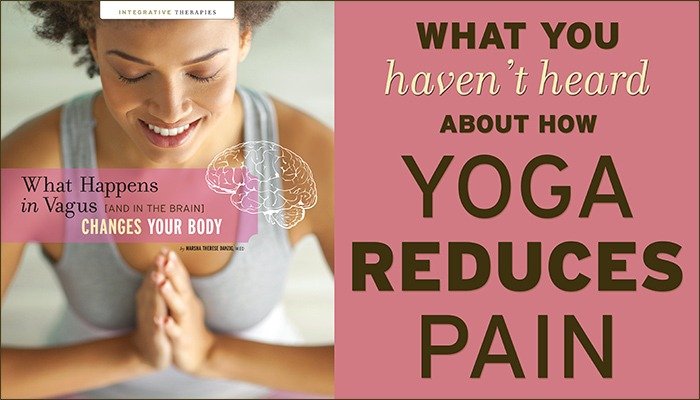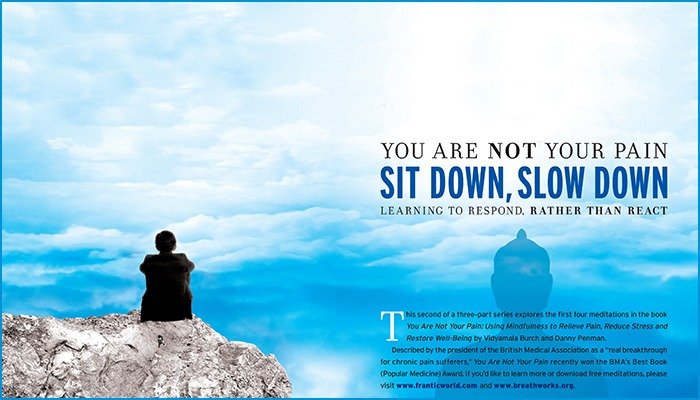How Yoga Reduces Pain

New Research and a rise in the practice of yoga as a healing therapy have led to new yoga specialties such as yoga for veterans, yoga for trauma and yoga for amputees.* Yoga, an ancient mind/body practice originating in India, enables a person in pain to shift focus, restructure ingrained responses, restore flexibility and increase breath capacity—all of which can improve one’s life experience.
Hatha yoga, from which all modern yoga is derived, is a combination of yoga postures and breathing exercises, designed to promote stillness and awareness, helping a person connect to life’s larger experience and remove limiting thoughts and sensations.
Included in the traditional practice of Hatha yoga are moral precepts for ethical living and self-care. Three of these precepts (compassion, non-grasping and non-stealing of time) are often overlooked in modern yoga practices but are critical to managing chronic pain.
Compassion is the foundation for all yoga practice. When someone in pain practices compassion for them-selves, their body unwinds so they have more capacity to be present with their situation.
Non-grasping is a practice of non-attachment to outcome. When a person clings to a belief about pain, a symptom of pain or an outcome of pain, they create more pain. By focusing on present-moment needs, the body relaxes.
Non-stealing refers to the ability to exist in the present. Chronic pain can lead to negative emotions that can interfere with or steal contentment in the present moment. Through yoga and stillness (non-stealing of time), a person can begin to redirect thoughts and negative emotions toward helpful action, such as self-care, commitment to well-being, contentment, self-reflection and surrender to a larger purpose. Energy increases.
3 KEYS TO PAIN RELIEF: POSING, BREATHING & MEDITATING
In addition to these three precepts, three key yoga elements (poses, breath and meditation) can help reduce pain. Yoga poses, or asanas, promote awareness of positive feelings in the body and allow one to observe, with a neutral mind, the places where pain resides. This can greatly diminish pain’s hold on the body.
Poses open up the psoas muscle, a long muscle that extends from the back to the pelvis, and connects the sympathetic/parasymphathetic nervous system. The psoas muscle allows us to stand up, and is related to our very survival. The stress of pain retriggers the psoas to tighten, which means less freedom to breathe, more stress and more fight-or-flight response. Releasing and lengthening the psoas frees up the diaphragm, therefore increasing the parasympathetic response: tend and befriend, rather than fight or flight. When a person in pain can rest the psoas in various yoga poses, stored tension (and emotions) can relax and let go.
Breathing techniques, or pranayama, accompany yoga poses. Pranayama is breath control. The greater the breath control, the more healing energy is available to reduce pain.
Both yoga poses and breathing reduce stress, increase breathing capacity, realign the skeleton, reduce muscle tension, remove toxic buildup in the fascia, relax the brain, move lymphatic fluid, increase proprioception and relax the sympathetic nervous system, strengthening the parasymphathetic nervous system.
When in chronic pain, the body is often in a contracted state, physically and mentally,which decreases blood flow. Yoga’s contraction and expansion through poses and breathing increases oxygen flow and creates homeostasis throughout the body so the person in pain is able to focus beyond the pain.
Pain relief can be immediate by focusing on the breath, but for lasting results a commitment to the practice of yoga is required. Also important is the recognition and understanding of one’s pain triggers and the body’s natural pain loops (pain pathways).
SECRETS OF VAGUS: HOW WHAT HAPPENS THERE CHANGES THE BODY
Deep, diaphragmatic breath physically strengthens the vagus nerve, the body’s great regulator and source of “gut feelings.” Stimulating the vagus nerve, a feeder of the parasympathetic nervous system, can improve depression, digestive issues, heart rate, sweating, spinal issues, skeletal alignment and colon health. Supporting the sensory/motor parasympathetic nerves, the vagus nerve provides the mind-body connection.
Opening the throat and breathing deeply, which happens during yoga, triggers the medulla (the lower portion of the brain stem) and stimulates the respiratory system. The enlarged airway (open throat) and increased lung space (created by enlarged ung sacs, or alveoli, from the increased air volume) boost oxygen intake and create a healthier life force in the body.Nostril breathing, another form of yoga breathing, is unique in that it slightly constricts the airwaves, which stimulates the vagus nerve. The chain reaction is immediate; cellular exchange and absorption of oxygen is more complete and the brain receives chemical signals that relax the body.
MEDITATION: THE BRAIN ON YOGA
Within a tenth of a second, the brain labels a new sensation as positive, negative or neutral. That means that aversion and craving are sealed into the chemistry of the brain and body. When the brain labels something “good” it says—Ooh, I want more of that. The reverse is also true.
When the brain is hyper-aroused, noraepinephrine in the brain can exaggerate an experience, especially fear, whether real or imagined. The chronic expectation of a particular result, such as pain, can create a loop, a time-space forward and backward continuum, as if the event that has not happened has already happened. Stress inhibits information to the prefrontal cortex, and the reptilian brain takeover. The system becomes rigid, and chaos ensues.
Through yoga, a person in pain can strengthen the prefrontal cortex, the bridge between emotion and action. In addition, yoga and meditation tap into the insula, the brain’s innermost area where the “happy place” lies. The prefrontal lobe and the insula are tightly joined to monitor the activities of the brain and the entire body system.
Research shows that meditation increases the size of the insula, therefore increasing resilience to pain and reducing reactivity to pain. When faced with triggers that formerly caused stress reactions, research indicates people in pain can better handle those triggers because brain cells associated with emotion and cognitive awareness are thickened.
Long-term yoga and meditation practices can have lasting positive impact on a person’s life. {PP}
Sources
1. Beilock, Sian, PhD. “How Mindfulness Meditation Alters the Brain.” Psychology Today online, June 3, 2011. http://www.psychologytoday.com/blog/choke/201106/how-mindfulness-meditation-alters-the-brain.
2. Berglund, Christopher. “How Does Meditation Reduce Anxiety at a Neural Level?” Psychology Today online, June 7, 2013. http://www.psychologytoday.com/blog/ the-athletes-way/201306/how-does-meditation-reduce-anxiety-neural-level.
3. Berglund, Christopher. Is Impaired Neuroplasticity Linked to Chronic Pain?” Psychology Today online, March 13, 2013. http://www.psychologytoday.com/blog/the-athletes-way/201403/is-impaired-neuroplasticity-linked-chronic-pain.
4. Brown, Richard. “Yoga Breathing: A Talk by Dr. Richard Brown.” February 23, 2005, UMASS-Amherst. http://rick.evertsz.name/731_kriyas/yoga_breathing_a_talk_by_dr.html.
5. Feurstein, Georg. The Yoga Tradition. Hohm Press, 1998.
6. Khalsa, Sat Bir. “Your Brain on Yoga.” Harvard Medical School Guides, December 2012.
7. Koch, Liz. The Psoas Book. Guinea Pig Publications (1997-05-01).
8. McCall, Timothy. “Yoga for Chronic Pain.” Yoga Journal online. http://www.yogajournal.com/for_teachers/2551.
9. Vallath, Nandini. “Perspectives on Yoga Inputs in the Management of Chronic Pain.” Indian Journal of Palliative Care, 2010 Jan-Apr; 16(1): 1-7.doi: 10.4103/0973-1075.63127.
10. Willson, Annie. “Yoga and Meditation for Balancing the Insula of the Brain.” Inner Light Publishers, 2010-2013. http://www.inner-light-in.com/2013/06/yoga-and-meditation-for-insula-of-your-brain/.
11. Zeidan, F, K. T. Martucci, R. A. Kraft, N. S. Gordon, J. G. McHaffie, and R. C. Coghill. “Brain Mechanisms Supporting Modulation of Pain by Mindfulness Meditation.” The Journal of Neuroscience, April 6, 2011,31(14): 5540 -5548. doi: 10.1523/JNEUROSCI.5791-10.2011, http://www.jneurosci.org/content/31/14/5540.abstract.
PainPathways Magazine
PainPathways is the first, only and ultimate pain magazine. First published in spring 2008, PainPathways is the culmination of the vision of Richard L. Rauck, MD, to provide a shared resource for people living with and caring for others in pain. This quarterly resource not only provides in-depth information on current treatments, therapies and research studies but also connects people who live with pain, both personally and professionally.
View All By PainPathways






